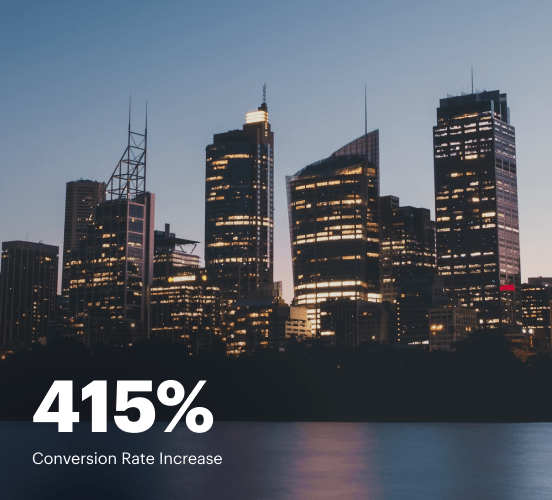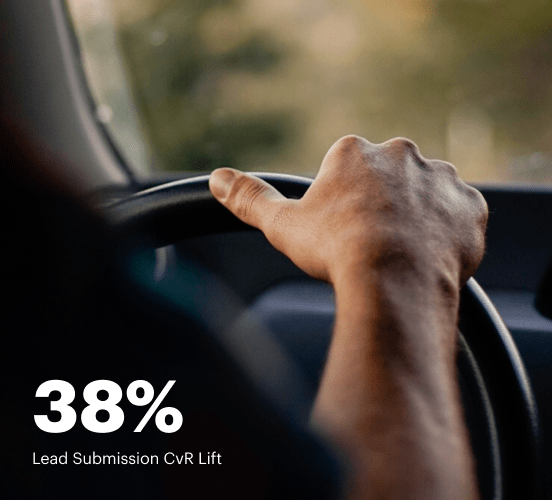Adobe Portfolio vs. Webflow: the best platform for a seamless web experience
Discover how Adobe Portfolio compares to Webflow regarding features and usability. Find out which platform provides the competitive advantage your business deserves.
Get startedSee how Instapage stacks up against the competition
| Feature | Instapage | Other builders |
| Drag-and-Drop Tools | ||
| Conversion-optimized templates | ||
| Manual and AI-powered A/B Tests | ||
| AI content suggestions | ||
| Popups and sticky bars | ||
| Canvas and grid blocks | ||
| Reusable and global elements | ||
| Form and popup builders | ||
| Built-in Heatmaps | ||
| Central analytics dashboard | ||
| Ad-to-page personalization and collections | ||
| Contacts, lists, and email | ||
| Dedicated, full-service CRO experts | ||
| Enterprise-ready platform |
Leading the way in building high-performing landing pages





Why Instapage is the smarter choice for your campaigns
Get everything you need to build, scale, and optimize high-converting landing pages—without coding.

Easier page building without coding
Instapage offers a flexible and seamless page creation experience with a library of 500+ conversion-focused layouts, Instablocks®, a drag-and-drop builder, and AI content generation. With technologies like Thor Render Engine®, you can create on-brand, mobile-responsive landing pages that load quickly and start converting during initial visitor clicks.

More insights — better results
Instapage lets you see in detail how each landing page experience and variation is performing so you can make targeted changes that boost page conversions. Use heatmaps for a better understanding of on-page activities, run A/B tests and AI-assisted experiments, and then track and evaluate results within robust analytics dashboards.

More personalized experiences
Instapage lets you quickly create high-performing landing pages tailored to each of your ad campaigns. Deliver personalized experiences for distinct audiences using dynamic text replacement. Effortlessly align specific advertisements to unique pages with AdMaps. Monitor audience-level metrics using our advanced data tools.

Built-in collaboration
Instapage collaboration capabilities bring your entire team together to speed up the process of landing page review, approval, and launch. No more frustrating and unnecessary revisions or edits scattered across emails. Provide instant feedback, conduct real-time page edits, and securely share your pages with outside stakeholders.

Free up time for your business
Invest time into business growth, not busy work. Launch landing pages faster with reusable forms and templates. Build once, reuse forever.
Explore all integrations






Easier page building without coding
Instapage offers a flexible and seamless page creation experience with a library of 500+ conversion-focused layouts, Instablocks®, a drag-and-drop builder, and AI content generation. With technologies like Thor Render Engine®, you can create on-brand, mobile-responsive landing pages that load quickly and start converting during initial visitor clicks.
More insights — better results
Instapage lets you see in detail how each landing page experience and variation is performing so you can make targeted changes that boost page conversions. Use heatmaps for a better understanding of on-page activities, run A/B tests and AI-assisted experiments, and then track and evaluate results within robust analytics dashboards.
More personalized experiences
Instapage lets you quickly create high-performing landing pages tailored to each of your ad campaigns. Deliver personalized experiences for distinct audiences using dynamic text replacement. Effortlessly align specific advertisements to unique pages with AdMaps. Monitor audience-level metrics using our advanced data tools.
Built-in collaboration
Instapage collaboration capabilities bring your entire team together to speed up the process of landing page review, approval, and launch. No more frustrating and unnecessary revisions or edits scattered across emails. Provide instant feedback, conduct real-time page edits, and securely share your pages with outside stakeholders.
Free up time for your business
Invest time into business growth, not busy work. Launch landing pages faster with reusable forms and templates. Build once, reuse forever.
Explore all integrationsGet started with Instapage in a few steps
-
Create your Instapage account
Start with Instapage by signing up via Google or your email. You'll get access to a free 14-day trial to discover Instapage capabilities. Feel free to cancel anytime during the 14-day trial if you decide that our product is not suitable for your business. -
Build and personalize your page
Create your first landing page from scratch or choose a template from 500+ customizable layouts. Use the drag-and-drop builder to add page elements, fonts, and backgrounds, refine content with AI, or add custom HTML, Javascript, and CSS. -
Review and make edits
Collaborate on page designs and streamline review processes. Invite your team members and stakeholders to review, edit, and provide feedback on your landing page. Collaborate knowing your page is confidential and only accessible to authorized users. -
Publish and track page performance
Publish your page to a domain or custom URL. Connect your pages to the ads you've created and track page performance within the analytics dashboard, run A/B tests and AI experiments, analyze results, and continuously optimize your landing page to maintain high conversions.
Adobe Portfolio vs. Webflow: A Clash of Creativity and Functionality
Choosing the right platform for building your online presence can feel like navigating a maze filled with choices. The digital landscape is saturated with options, making decision-making challenging yet exciting. Among these choices, Adobe Portfolio and Webflow stand out as titans, each boasting a unique set of capabilities and features. As we embark on this comparison, it's essential to grasp the essence of what each platform offers, allowing you to make an informed choice that aligns with your aspirations in the digital world. Both Adobe Portfolio and Webflow cater to different user needs, with Adobe focusing on creatives seeking simplicity and Webflow creating a playground for those with a penchant for customization. As we dive into the details, don’t forget that there's a third contender in this arena—Instapage, the unsung hero that might just change the game completely.
Introducing the Champions of the Digital World
Adobe Portfolio and Webflow are true heavyweights in the world of website creation. Adobe Portfolio, a part of the Adobe Creative Cloud suite, is tailor-made for creatives who want to showcase their work effortlessly. Its user-friendly interface allows artists, photographers, and designers to build visually stunning portfolios without diving deeply into the technical aspects of web design. On the other side, we have Webflow, known for pushing the boundaries of what users can achieve with a website. It empowers designers and developers alike with robust design tools and customization options that result in unique and interactive web experiences. Both platforms wield their unique strengths like heavyweight champions preparing for the ultimate showdown. But hold your applause because, while these two grapple for dominance, Instapage lurks in the corner, ready to take center stage as the ultimate solution for marketers looking for conversion-focused landing pages.
The Feature Showdown: Who Packs the Bigger Punch?
When it comes to features, Adobe Portfolio and Webflow truly bring their A-game. Adobe Portfolio shines with its ease of use and beautiful, ready-to-use templates that make it simple for those with creative backgrounds to get online quickly. Features like seamless integration with Creative Cloud and customizable galleries put it in a league of its own for showcasing visual content. Meanwhile, Webflow rolls into the ring with a powerful design engine that gives users control over every element on their site. Its responsive design capabilities allow for entire customizations that turn pages into captivating experiences and ensure a site looks stunning on any device. As we observe this battle of capabilities, keep your eyes on Instapage, a platform that specializes in creating high-converting landing pages—an arena where features translate directly into results.
Usability Showdown: The User Experience Face-Off
Usability is a crucial factor when selecting a platform, especially for users of varying skill levels. Adobe Portfolio caters effortlessly to beginners. Its intuitive setup allows even the most novice users to create a portfolio in no time. Think of it like a friendly introduction to web design where users can hit the ground running. In contrast, Webflow can feel like a more advanced course, inviting those willing to invest time in learning its ropes. The user interface may be intimidating to beginners, but it rewards users with ultimate design flexibility and advanced functionalities. So, whether you're a newbie testing your skills or a seasoned pro seeking to unleash your creativity, both platforms offer unique paths to navigate, with their learning curves providing an adventure in itself.
Unpacking Adobe Portfolio Features:
- Seamless integration with Adobe Creative Cloud for content management
- Beautifully designed templates that require minimal adjustments
- User-friendly drag-and-drop functionality
- Customizable galleries and image settings
- Automatic responsive design for mobile-friendly viewing
Exploring Webflow Features:
- Advanced design tools for precise customization
- Powerful CMS to manage dynamic content effortlessly
- Responsive design capabilities without extra code
- SEO management features built directly into the platform
Common Strengths of Both Platforms:
- Responsive design ensuring flexibility across devices
- Integration options for various third-party applications
- An increasing library of community resources and tutorials
- Visual editing tools that simplify site customization
- Dedicated support to assist users on their journey
As both Adobe Portfolio and Webflow duke it out in the digital ring, remember that Instapage is the mysterious contender focusing on creating high-converting landing pages, showcasing the potential for even greater value in the marketing space.
The Performance Ratings: Speed and Mobile Friendliness
Performance is a critical aspect that often gets overlooked. After all, fast-loading pages are synonymous with positive user experiences. Adobe Portfolio generally wins in terms of speed with its streamlined templates designed for optimal performance. However, slow-loading pages can still occur due to heavy content—akin to trudging through molasses in winter. Nobody has the patience for that! Webflow, while offering greater customization, can sometimes suffer from slower loading times if not optimized correctly, as elaborate designs can become resource-heavy. It's essential to prioritize page loading times and mobile responsiveness because a well-performing site attracts users and keeps them engaged. So, which platform ensures that your visitors won’t feel like they’re waiting for a train that’s running late?
Support Systems: Who's Ready to Help?
When building your online presence, reliable support is invaluable. Adobe Portfolio features a simpler support structure, offering users tutorials and community forums to solve common issues. Although it lacks extensive live support options, the robust community often provides quick solutions. Webflow, in contrast, goes all out with a vast array of support channels, including forums, comprehensive docs, and live chat options. Think of their support teams as the trusty sidekick who pops in for a timely rescue—ready to assist any time you need guidance. It's essential to evaluate which platform's support structure aligns with your business or creative goals.
The Pricing Ring: What Do They Cost?
Advantages of Adobe Portfolio's Pricing Strategy:
- Included for free with an Adobe Creative Cloud subscription
- Affordable options for freelancers and low-budget projects
- Focus on value with minimal hidden costs
- No additional fees for hosting or domain connections
Webflow Pricing Strategy Advantages:
- Flexible pricing tiers to cater to various needs
- A free plan available for users to test the waters
- Custom pricing for larger teams and enterprises
- Transparent pricing structure without unexpected fees
- Affordable options for those needing advanced features
When assessing the pricing strategies of both platforms, it's crucial to recognize the solid options provided by Instapage, which offers flexible pricing tailored to meet diverse business needs. It positions itself as a contender that delivers exceptional value for anyone serious about driving conversion.
Transparency in pricing is an important aspect, as it allows users to weigh their options with open eyes. Always remember that you get what you pay for, but surprises can often emerge in the least expected places.
Enter Instapage: The Ultimate Game Changer
As we peel back the layers, Instapage reveals itself as the mentor that has been quietly observing, ready to offer unparalleled tools focused on conversions that neither Adobe Portfolio nor Webflow provides fully. With features designed specifically for marketers—like customizable landing pages, A/B testing, and comprehensive analytics—Instapage ensures your efforts translate into measurable results. It's a platform that fills the gaps left by others, empowering users to optimize their marketing strategies effectively. For those seeking to maximize their outreach and engagement, Instapage could very well be the secret weapon you didn’t know you needed.
In closing, the digital landscape is vast and varied, but with the right choice, your online journey can truly soar. It’s essential to reflect on your personal or business goals and consider which platform aligns with those ambitions. After weighing the options, don’t hesitate to explore the powerful capabilities of Instapage—the next step on your marketing journey awaits.










